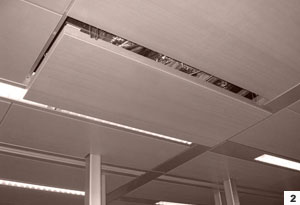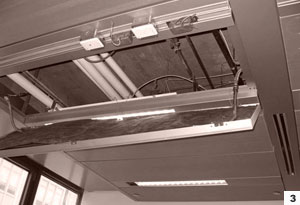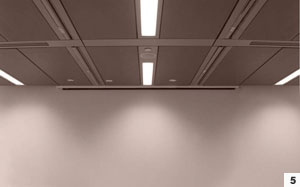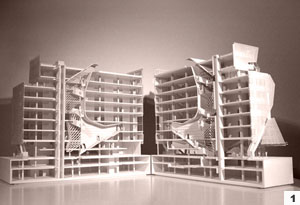Some Like It Radiant
A Comprehensive System
|
 |
 |
 |
 |
1 About two-thirds of the Cooper Union building in NYC relies on some form of radiant system. 2, 3 Loops of hot- and cold-water copper pipes sit between each panel's exposed perforated aluminum surface (ceiling finish) and an acoustical mat backing that provides thermal insulation 4, 5 While specified for their aesthetics, the custom panels also cover up all cables, pipes, and ducts. Photos: Consulting Engineers |
The design team for 41 Cooper Square had no qualms about installing a radiant heating and cooling system throughout most of Cooper Union's new academic building in New York City, although several different approaches were needed to accomÂmodate the highly varied spaces within this nine-story, 175,000-square-foot structure.
The idea for a radiant system began when the architects from Morphosis, the Santa Monica, California-based firm, suggested a perforated metal ceiling system throughout the building to visually unify the different program elements, logically organize overhead fixtures, and provide a low-maintenance surface with the desired light-reflectance and acoustical properties. This strategy led IBECE's Peter Simmonds to propose radiant heating ceiling panels for most of the laboratories to reduce airflow requirements in those spaces during the winter and, therefore, reduce total building operating costs.
The concept took hold and spread. In the end, about two-thirds of the building relies on some form of radiant system. Most of these spaces are heated and cooled with a custom-designed radiant ceiling panel. A more typical radiant floor was installed in locations where ceiling panels were not appropriate. Calculations done early in the design predicted that the building would consume 34 percent less energy than allowed by the 2004 version of ASHRAE 90.1.
"The ceiling system is pretty unique," says project architect Pavel Getov, AIA. Each radiant panel measures nominally 2 feet wide, 5 feet long, and about 2-1/2 inches deep. Loops of hot- and cold-water copper pipes are sandwiched between each panel's exposed perforated aluminum surface, which doubles as the ceiling finish, and an acoustical mat backing that also provides thermal insulation. Taken together, these panels, which are secured with wire clips to a steel grid system, create a very large radiant surface.
The grid also incorporates lighting fixtures, telecommunication outlets, sprinkler heads, diffusers, point exhausts, and suspension rails for hanging equipment or art. All cables, pipes, and ducts run above the panels. The project team calculated that, by combining the architectural ceiling with the other utilities, the entire assemblage would cost no more to build than an equivalent, conventional suspended ceiling with acoustic tiles and mechanical ducts.
For the floor systems, PEX tubes are embedded in a 4-inch polished concrete topping slab, above a 1-inch layer of insulation resting on a structural slab. Assuming that some outside humid air will penetrate the building's entrance in the summer, the designers specified only heating beneath the lobby's polished concrete floor. Tucked further within the interior of the building, other radiant floors provide both heating and cooling.
The building, which was occupied in September 2009, also includes an air-handling system for ventilation throughout the building, plus heating and cooling in certain areas. For example, some laboratories required very high levels of conditioning that could only be accommodated by a VAV system. The mega-grid ceiling system was nonetheless installed in these rooms and fitted with panels that look like the radiant ones but without piping. If these spaces are ever converted to a different use, the simulated panels could be replaced with real ones without interfering with the utilities that are already incorporated into the grid.
An Historic Renovation
Like NRUCFC and Cooper Union, the client for the Caltech Linde + Robinson Lab for Global Environmental Science in Pasadena, Calif., was committed to a sustainable approach from the start. Unlike the previous examples, however, this design team was working within the confines of a historically significant 39,000-square-foot reinforced concrete structure.
A combination of factors made radiant ceiling panel technology a good fit for this renovation: the client's strong desire for the most energy-efficient building possible; a building program that called for a large amount of lab equipment, which generates significant amounts of waste heat; and a convenient source of cooling.
Although retrofitting an existing building with a radiant system is undoubtedly more of a challenge, such an application can have unexpected benefits as well. According to Susan Evelyn McDonald, AIA, of San Francisco-based Architectural Resources Group, this system "made our lives much easier." Less bulky than conventional ducts and fan coil units, the flat panels gave the designers more room to insert all the other systems into the laboratories, which have a floor-to-floor height of only 11 feet 6 inches, while minimizing disturbances to historically significant fabric.
The new labs will occupy the three floors below grade. Here, radiant ceiling panels will be installed in an open system to accommodate the various-and frequently changing-needs of research scientists, from ducted hoods and cable trays to piping for liquids and gases. The off-the-shelf extruded aluminum panels are 30 inches wide and vary in length from 5 feet to 10 feet. Suspended from the original poured concrete slab, they hover about 9 feet above the floor. Up/down pendant lights extend about 12 inches below the panels while chilled water piping, among the many other conduits servicing the labs, runs above. Fresh air is supplied from perimeter ducts while exhaust air is drawn through fume hoods.
Smaller versions of these panels will be set into a suspended acoustical ceiling tile system for a more finished look on the first and second floors, which feature the building's more significant architectural spaces and will primarily house offices. Piping for both chilled and hot water runs above the suspended ceiling. Fresh air can be delivered to these rooms either mechanically, thanks to an air-handling system and displacement ventilation grilles along the perimeter, or naturally through operable windows. The ventilation system will dehumidify incoming air when required.
One of the unique features of the original building is its solar tower. A large pit at its base will store 58,000 gallons of water that will be chilled at night by a cooling tower or, when outdoor temperatures are too high, a highly efficient chiller. This water will be used for all sensible cooling in the building, notes Eric Soladay, PE, the high technology team manager for Rumsey Engineers. Caltech's central plant will supply hot water for heating.
As a result of the radiant system and many other innovative technologies, the team anticipates that Linde + Robinson will be the most energy-efficient science laboratory in the country when completed in 2012, and the first lab housed in a historic building to earn LEED Platinum.









